Disclosure: Meeple Mountain received a free copy of this product in exchange for an honest, unbiased review. This review is not intended to be an endorsement.
I was gazing around the table, at my cards, at the ceiling, even at my phone, miserably slogging my way through the night.
We were getting close to the third hour of our first game of Nova Era, the newest design from Andrea Chiarvesio. I don’t think Chiarvesio has the name recognition of some of his peers, but at the Bell household, Chiarvesio is a staple—he designed one of my favorite Euros ever made, Kingsburg, a game I love so much I didn’t even bother reviewing it so much as straight-up loving on it.
At five players, Kingsburg is the perfect game. (I don’t care what anyone thinks. Kingsburg is life!!!) There is always tension, there is always cursing, and there is always a goblin horde lurking just outside the castle walls. I prefer the artwork of the first edition but the extra content that comes with the third, so the third edition of Kingsburg is the one that will live on forever.
Unfortunately, Nova Era is not Kingsburg. In part, this is due to an identity crisis that I’m still struggling with.

The Normal Variant is the Long Game
Nova Era, a CMON production released earlier this year, accommodates 2-4 players bent on building up the best civilization across three eras. However, I would not call Nova Era a “civ game”, at least not the way we know them in these parts. I would call Nova Era a technology tableau-building game. To distill the game’s essence down to something manageable: across nine rounds, players take turns drafting three dice from a pool then using the dice to buy cards from a market and trigger one-time, ongoing, and/or production actions while trying to score the most points.
Like Kingsburg, Nova Era is a very low-scoring affair—winners will likely end up near the end of the 40-point scoring track, and there are no tokens for scores that exceed 40. And, like Kingsburg, Nova Era’s main tension points start with the die rolls established each round. High pip values are generally good, but high pip values also come with issues that can trigger a variety of situationally negative effects.
One last comparison—Nova Era, like Kingsburg, is sneakily interactive. Many tableau builders, especially games like a recent favorite, Ancient Knowledge, can turn into very heads-down “multiplayer solitaire” experiences. (Hello, Ark Nova!) Player X builds cards from hand or a market, gets resources, mutters to themselves, then announces that they must pass. In Nova Era, right from the jump, everyone is in everyone else’s way.
The dice draft is dramatic, thanks to five different colors of dice that might potentially be available. The dice draft gets extra spicy when there are fewer players, because this creates the possibility that certain die colors do NOT appear during the dice draft phase. Some technology cards attack other players. Some cards let a player steal resources from an opponent. In the game’s second and third Eras, some cards phase other techs out of the game altogether, helping to destroy much of the work you may have done to build up a scoring and production engine.
I wouldn’t have guessed this during the initial readthrough of the rules, but Nova Era is downright nasty at times. In my first four-player game, one player marked himself for death when he built up an engine of red (military) cards in his tableau. Announcing his powers to the table during the first Era, this player—who may or may not still write for this website, based on my feedback—waited for everyone else to collect their production income before boldly stealing one resource from each player for his own benefit.
He did that five rounds in a row!!!
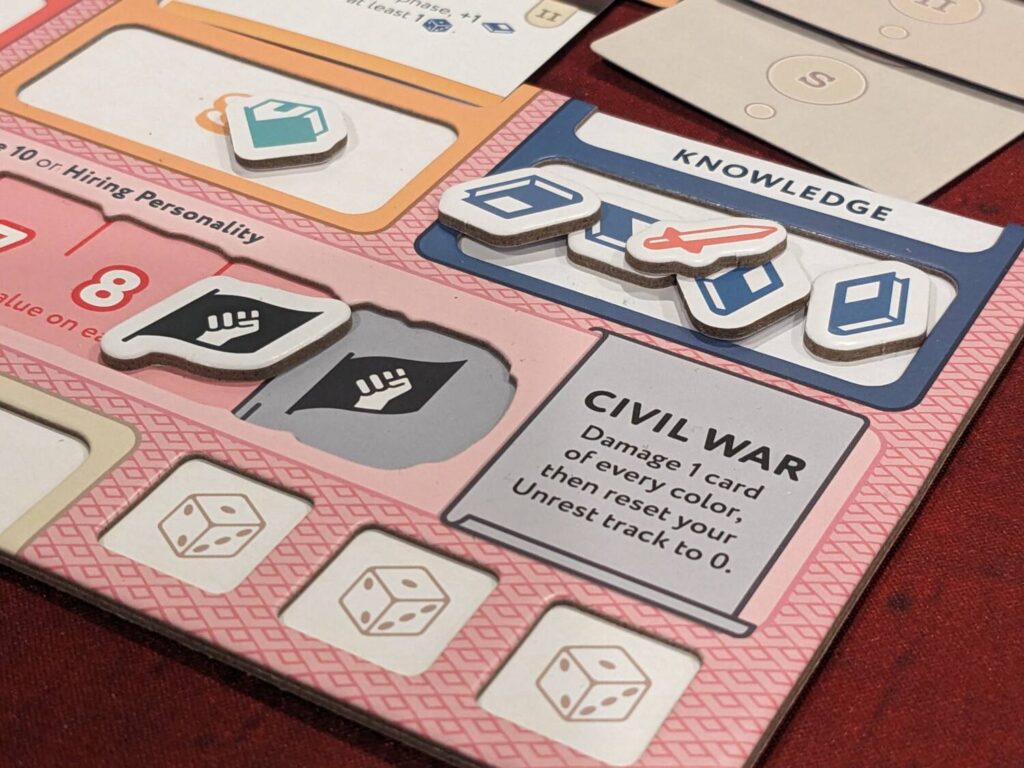
Nova Era, then, is not for the weak of heart. I can think of a few times where a player would finish a season (die-rolling and placement phase) of Kingsburg and come up mostly empty, but not emotionally distraught. Nova Era was a punch in the face, and that’s coming from someone who spent hours in misery “enjoying” the sweet taste of Iconoclasm & Heresy!!
Nova Era’s stumbles begin with the game’s overall length in the normal play mode. I noted in the rulebook that Nova Era has a “fast play” variant, where players only complete six rounds instead of nine (across two Eras instead of three). However, for the first play of any game, I play it using the game’s normal rules…and even during the end-of-Era scoring after the first Era, I had a feeling that the short variant is the way to go.
That’s because the third Era of Nova Era is essentially the final round of games like Empire’s End, Space Station Phoenix, or other games that celebrate burning everything you have built to the ground. In Nova Era, each Era has its own technology and “personality” deck, with those latter cards representing famous figures from real-world history, from Alexander the Great all the way to Albert Einstein.
Every technology card that a player can build in the third Era makes at least one card from the first Era obsolete. The world is moving forward, the game reminds you, and that is personified in game form by wiping cards out. Imagine if you had a sexy tableau of Era I, II, and starter techs, only to watch your world melt away each turn.
Nova Era doubles down on this by also making it hard to build Era III technologies. So, cards that are being built ravage other cards, while some players won’t have the dice or the resources to build much of anything late in the game. And I haven’t even detailed a step that boosts the track value of the five die colors…because the short version is that the card colors are tied to the die colors, and periodically, certain cards can be damaged and temporarily removed from play.
By the end of my first play, my civilization was in tatters. I was mostly spending time baling water from the basement of my faulty home, only to see a forecast that included torrential rain for the next three days.
And that is when I began to consider the game’s short variant. Maybe in that next game, it will be more exciting to build things that will stand the test of time, with that test lasting for only six rounds? For our second play, we did just that…and made a discovery that made the whole enterprise worse.

“But This Porridge is Cold”
For our second play, we did a three-player game using the Fast Play variant. Two of the players were involved in the first play, and we inserted a third player who had not played before.
The second game went 75 minutes. It was shorter, which was the main goal of the Fast Play variant. But it was strangely empty and a little bland. Worse, it revealed one of the big issues we had in the first game: the Personality cards are too vital to a balanced scoring attack. That left players constantly looking to draft black dice, and in a surprise to no one, the player who drafted the most Personality cards won this shorter variant in a landslide.
Not the player who had the best engine. Not the player who had the best diversity of color cards, which is the main way to score at the end of each Era. No…the player with the most Personality cards.
We certainly noticed that Personality cards are important during our first game…in fact, it provided most of my points in that first game and provided me with a second-place finish. But in the short game, they are best in show. They provide powers and Era scoring that are crucial. No player is going to have the color majority in all five suits, because everyone is building cards and it would be challenging to imagine a player winning majorities in all five colors. But Personality cards are quite rare (only two per player are placed into the card market each Era) and each Personality is worth 2-3 points, in a game where 30 points is a massive amount.
And in the short game, you won’t have enough time to take advantage of a good engine. Maybe you’ve got a good drip of resources, but if you didn’t combine those resources with the right dice, those resources are worth almost nothing at the end of a two-Era game. As one player noted, building the engine in a tableau building game is always the fun part. What if you never get to see that engine do anything?
So we found ourselves in a tough place. The long game is too long (especially with new players, so we know that timeframe narrows with experienced players), and the short game is way too short.

Here’s How to Enjoy Nova Era
Even after two plays, I know where I land on the overall experience: play Nova Era at least once, ideally with a three-player count, using the base game variant. The “Fast Play” variant isn’t worth it because the game’s arc doesn’t meet the moment with only six rounds.
With two players, I don’t think enough dice colors will come out, leading to an experience that will lean too tactical for a strategy game player in a low-scoring affair. With two players, some cards become pretty weak, such as catch-up-mechanic techs that benefit a player behind in points, or cards that allow the robbery of all other opponents.
A note regarding catch-up mechanics—unfortunately, Nova Era has a lot of them, so in a game where a player appears to have a runaway lead, trust me when I say (from experience) that you are always in a game of Nova Era. Even with scores that top out in the mid 30s, having a six- or seven-point lead can melt away quickly because so many cards have the ability to topple the scoring leader’s tableau.
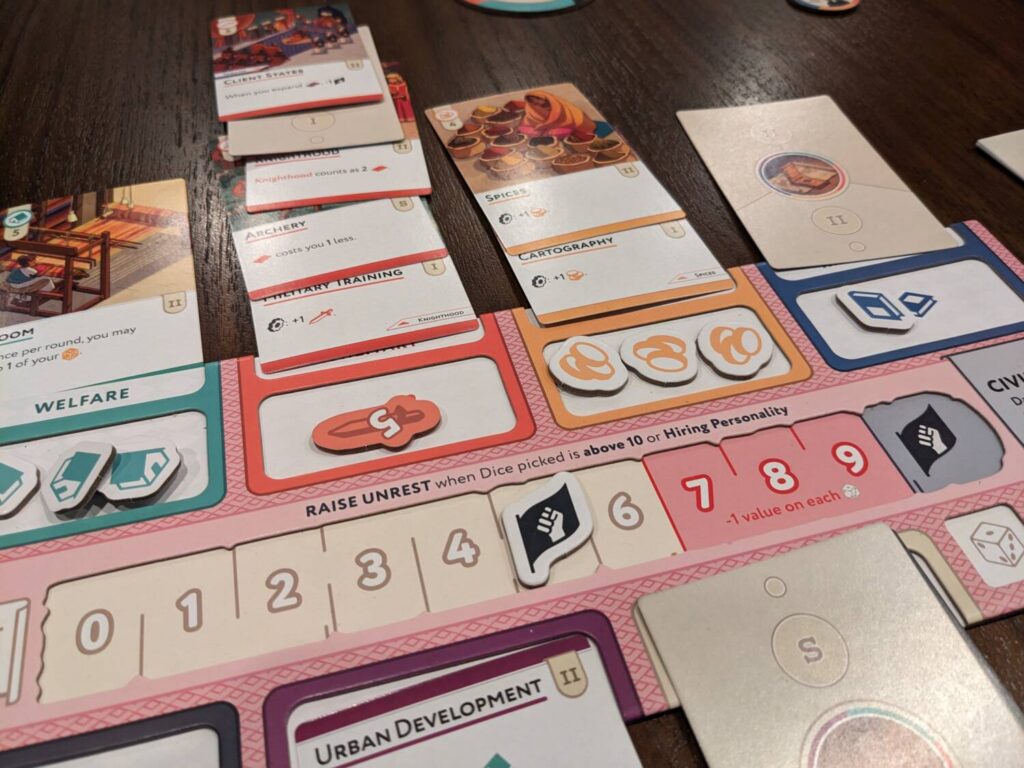
Other mechanics here feel extraneous. There is a sixth type of card, known as Territories, but those cards are very limited in terms of supply and I think the game would have been just fine without them. The black dice in the game provide the ability to both buy Personality cards from the market as well as give a player the best chance to lower their unrest. Keeping Unrest low is important to help players avoid some of the negative effects tied to drafting high-pip dice.
The game’s interaction level is solid, and the dice drafting is a blast. I love the artwork by Agnès Ripoche, who also did the illustrations for The Architects of Amytis, and as a production, Nova Era is pretty slick, from the storage solution to the rulebook to the back-of-the-manual player aid. (Yep, this game needed more personal player aids, like every game these days!)
There’s a nice variety of cards in the box, so while there is plenty of room in each card bin within the box for expansion cards, Nova Era doesn’t need any. In fact, some players suggested that continued plays help a player focus on the personality cards or certain technologies that might be best to aim for when building an initial strategy.
Give Nova Era a look if you are a fan of tableau builders, especially if you regularly play games with the same three-person play group. At three players and playing the full three-Era game, there’s something here.


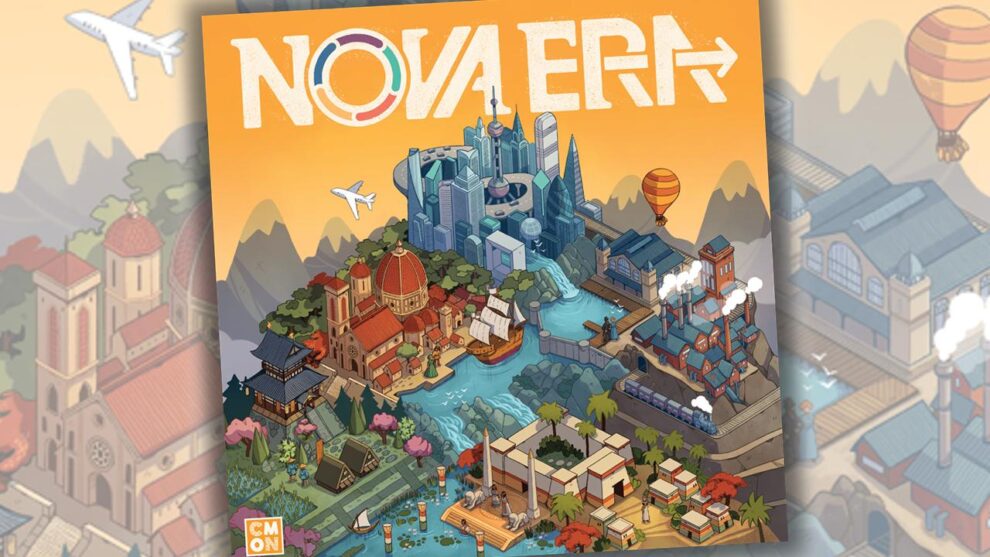
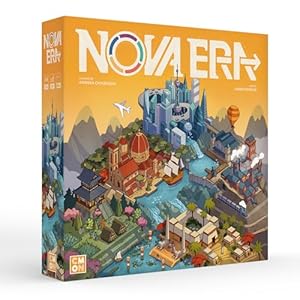
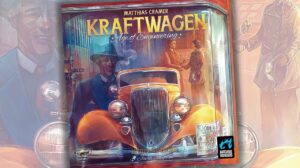

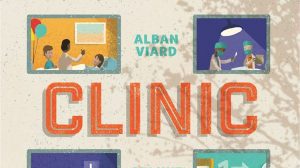



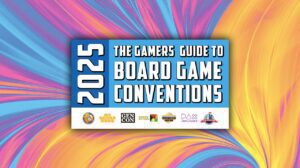
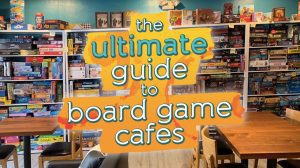
Add Comment